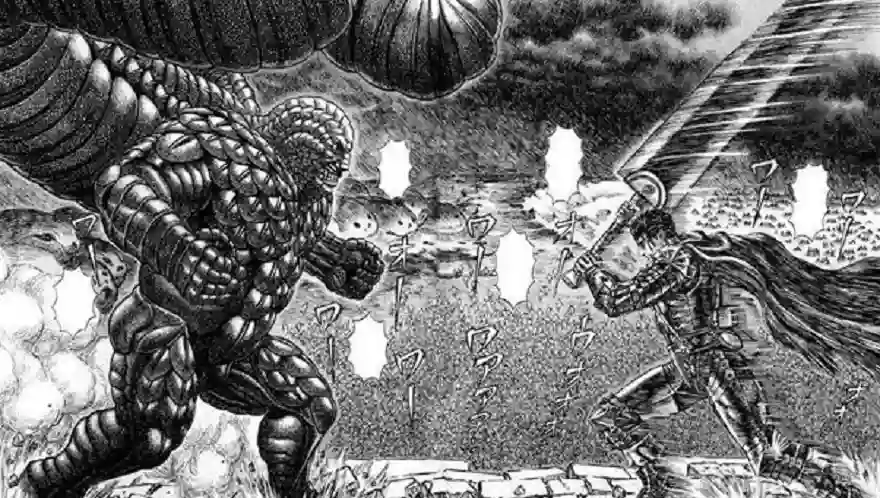Kentaro Miura’s dark fantasy manga, “Berserk,” is renowned for its intricate storytelling and meticulous artwork. Within the narrative, one aspect that stands out is the vivid and often brutal depiction of violence. While violence is a central element of the story, what sets “Berserk” apart is the way in which Miura approaches the portrayal of brutality. In this article, we will explore how “Berserk” achieves an artistic beauty in its depiction of violence, blending stunning visual artistry with narrative depth.
The Brutal Realism of “Berserk”
“Berserk” is a world steeped in darkness, where violence is an ever-present force that shapes the characters and their experiences. The story follows Guts, a lone swordsman who becomes embroiled in a brutal and unforgiving world filled with demons, supernatural entities, and morally complex characters.
The violence in “Berserk” is not gratuitous; rather, it serves as a reflection of the harsh and unrelenting nature of the world in which the characters reside. Miura’s commitment to portraying violence in a realistic and impactful manner is evident in his meticulous attention to detail.
The Artistry of Combat
One of the key elements that contribute to the artistic beauty of violence in “Berserk” is the stunning choreography and composition of combat scenes. Miura’s skill as an artist shines through in the fluidity and dynamism of the battles he depicts.
The intricate details of weaponry, armor, and the characters themselves are meticulously rendered, immersing readers in the visceral experience of combat. Every strike, parry, and clash of swords is captured with a level of detail that makes the action sequences visually captivating.
Miura’s use of panel layout and composition enhances the impact of these scenes. He employs a variety of panel sizes and shapes to convey the flow of battle, creating a sense of movement and intensity that draws readers deeper into the action.
The Emotional Weight of Violence
Beyond the technical artistry of combat, “Berserk” excels in conveying the emotional weight of violence. Miura’s characters are not mere warriors; they are individuals with their own motivations, fears, and vulnerabilities. The manga delves into the psychological toll that violence takes on its characters, highlighting the trauma and scars that linger long after the battles have ended.
Guts, the protagonist of “Berserk,” serves as a prime example of the emotional complexities associated with violence. His life is marked by relentless combat, and the toll it takes on his body and psyche is palpable. Miura portrays Guts as a character who is both a formidable warrior and a deeply wounded individual, adding layers of depth to his character.
The juxtaposition of beauty and brutality is particularly evident in the moments of introspection and vulnerability that follow violent encounters. Miura’s ability to convey the emotional aftermath of violence makes the reader empathize with the characters on a profound level.
The Dark Themes of “Berserk”
“Berserk” explores dark and morally complex themes, and its depiction of violence is intrinsically tied to these themes. The manga delves into questions of power, destiny, and the human capacity for both greatness and moral descent. Violence serves as a vehicle for these themes, pushing the characters to their limits and forcing them to confront the darkness within themselves.
The supernatural elements of “Berserk” add another layer of complexity to the violence portrayed in the series. Demons, apostles, and the God Hand are all part of the narrative, and their encounters with the human characters are often violent and otherworldly. Miura’s ability to seamlessly blend the supernatural with the visceral creates a unique and compelling experience for readers.
The Evolution of Artistic Style
One of the remarkable aspects of “Berserk” is the evolution of Miura’s artistic style over the years. The manga was serialized for several decades, allowing Miura to refine his craft and experiment with different artistic techniques. As a result, readers can witness the growth and development of his artistry as the series progresses.
Miura’s early illustrations in “Berserk” are characterized by a raw and gritty style that emphasizes the brutality of the world. As the series continues, his art becomes increasingly detailed and refined, showcasing his mastery of anatomy, perspective, and composition. This evolution in artistic style enhances the beauty of violence in “Berserk” and contributes to the manga’s enduring appeal.
Conclusion
“Berserk” stands as a testament to the artistry that can be found within the depiction of violence in manga. Kentaro Miura’s meticulous attention to detail, his ability to convey emotional depth, and the evolution of his artistic style all contribute to the artistic beauty of violence in the series.
While “Berserk” is undeniably dark and violent, it is also a work of profound artistic expression. The violence serves as a vehicle for exploring complex themes, and it is a testament to the human condition in a world that is both beautiful and brutal. “Berserk” continues to captivate readers with its unique blend of narrative depth and visual artistry, making it a true masterpiece in the realm of dark fantasy manga.









